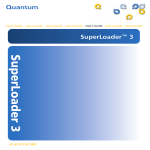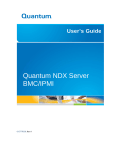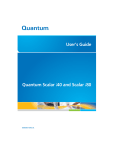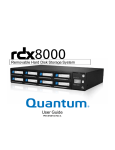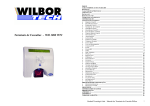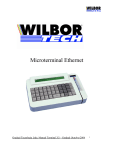Download Quantum Scalar i80
Transcript
Scalar i40 and Scalar i80 Contents Required Tools and Equipment .............. 2 Environmental Requirements ................ 2 Taking ESD Precautions .......................... 2 Unpacking the Library............................ 3 Scalar i40 and Scalar i80 Quick Start Guide Accessory Kit Contents .......................... 5 Installing the Library in a Rack or Desktop Kit............................................. 5 Installing the Tape Drives ....................... 5 Connecting the Cables ........................... 7 Turning the Library ON and Configuring Network Settings ................................... 8 Accessing the Library Via the Web Client .................................................... 13 This quick start guide provides basic installation and configuration instructions for the Scalar® i40 and Scalar i80 libraries. For more information, see the Quantum Scalar i40 and Scalar i80 User’s Guide located on the documentation CD provided with your library. Configuring Partitions.......................... 14 This instruction uses the following conventions: Saving the Library Configuration ........ 17 Running the Installation and Verification Test ....................................................... 14 Importing Tape Cartridges ................... 15 Configuring the Host Software............ 17 Caution: Cautions indicate potential hazards to equipment and are included to prevent damage to equipment. Registering the Library......................... 17 WARNING: Warnings indicate potential hazards to personal safety and are included to prevent injury. Scalar i80 Scalar i40 www.quantum.com Scalar i40 and Scalar i80 Quick Start Guide Required Tools and Equipment • Ethernet cable Environmental Requirements The installation site must have the following environmental conditions: • Humidity 20% – 80% non-condensing • Temperature: 50°F – 95°F (10°C – 35°C) • Altitude: –500 to 10,000 feet (–152 to 3048 meters) These environmental conditions apply when the Scalar i40 and Scalar i80 libraries are in operation. For additional specifications, refer to the Quantum Scalar i40 and Scalar i80 User’s Guide. In addition, install the library in a location that is as free from dust as possible. Dust can damage or degrade performance of library components and media. Taking ESD Precautions Some components within the Scalar i40 and Scalar i80 libraries contain static-sensitive parts. To avoid damaging these parts while performing installation procedures, always observe the following precautions: • Use an antistatic wrist strap. If you do not have one, touch the outside of the library on the sheet metal before touching any components to discharge static from your body. • Keep static-sensitive parts in their original shipping containers until ready for installation. Look for the ESD sticker to identify static sensitive parts. • Avoid touching connectors and other components. Note: Dry climates and cold-weather heating environments have lower relative humidity and are more likely to produce static electricity. 2 Required Tools and Equipment Scalar i40 and Scalar i80 Unpacking the Library Note: Unpack the library as close to the installation location as possible. 1 Inspect the outer library packaging for damage. If there is any damage evident on the library packaging, do not continue with the installation and contact Quantum customer support. 2 Open the library packing box and remove the kit tray containing the accessory kit and rail kit (see Figure 1). Some configurations come with tape drives installed in the library, and some come with tape drives packaged separately. If yours comes with tape drives packaged separately, remove them and set aside for installation later. Figure 1 Packaging Accessory kit Rail kit Kit tray Media labels Top foam Bottom foam Shipping carton Bottom tray (Scalar i80 only) Scalar i40 Pallet (Scalar i80 only) Scalar i80 Unpacking the Library 3 Scalar i40 and Scalar i80 Quick Start Guide 3 Remove the top foam. 4 Scalar i80 only: Remove the shipping carton by lifting it straight up out of the bottom tray. 5 With the help of a second person, lift the library chassis out of the bottom foam and place it on a table approximately waist high. WARNING: Two people are required to safely lift the library out of its packaging or into a rack. Caution: Lift the library chassis at the sides. Avoid putting the weight of the library chassis on the front bezel. 6 Remove the anti-static wrapping from the library. Keep the anti-static wrapping intact so that you can use it later if needed. 7 Save the packing box, packaging material, and anti-static wrapping in case you need to move or ship the library in the future. 8 Remove the robot restraint. The robot restraint consists of four (4) thumbscrews, a plastic sheet, and a small metal clip, located on the top cover of the library. (See Figure 2.) a Unscrew and remove the four thumbscrews from the top cover (see Figure 2). Save the thumbscrews in case you need to move or ship the library in the future. Note: The robot may stay at the top of the library, or it may move downward toward the floor of the library. If it moves downward, you will hear the gears turning as it moves. This is normal. b Remove the plastic sheet and metal clip and discard. You will not need to use them again. Figure 2 Removing the Robot Restraint 4 Plastic sheet Metal clip Unpacking the Library Scalar i40 and Scalar i80 9 Once you remove the robot restraint, you may cover the holes in the library top cover with stickers, which are provided in the accessory kit for this purpose. This step is optional and is intended to prevent small objects from accidentally falling into the library through the holes. 10 Remove the protective plastic sheet covering the front panel display. Accessory Kit Contents • Power cord(s) – one for each power supply • Scalar i40 and Scalar i80 Documentation and Training CD • Scalar i40 and Scalar i80 Quick Start Guide • China RoHS statement • System, Safety, and Regulatory Information Guide • Stickers (clear, round) to cover holes in library top cover Installing the Library in a Rack or Desktop Kit Follow the instructions that came with your rail kit or desktop kit to install the library. Installing the Tape Drives If your library already has tape drives installed, skip this section. Tape Drive Slot Location Considerations Tape drives can only fit in certain slots, as described below and illustrated in Figure 3. Slots are numbered starting from the bottom and moving up. • Scalar i40: Half-height tape drives can be installed in slots 1 and 2. • Scalar i80: Half-height tape drives can be installed in slots 1, 2, 3, 4, and 5. It is recommended to start installing the tape drives at the bottom slot and work up, without leaving spaces between. Accessory Kit Contents 5 Scalar i40 and Scalar i80 Quick Start Guide Figure 3 Acceptable Installation Locations for Half-Height Tape Drives Tape Drive Slot 5 Tape Drive Slot 4 Tape Drive Slot 3 Tape Drive Slot 2 Tape Drive Slot 2 Tape Drive Slot 1 Tape Drive Slot 1 Scalar i40 Installation Instructions Scalar i80 1 If needed, remove filler plates from the back of the library to make room for the tape drives. Unscrew the two captive thumbscrews and pull the filler plates out of the library. Save the filler plates in case you need to use them in the future. 2 Unpack the tape drive and tape drive cable. Caution: The tape drive always resides in a drive sled, and together they are effectively one unit. Do not remove the tape drive from the drive sled. 3 Insert the tape drive into the drive slot. The “shelf” on the bottom of the drive sled fits into the notch in the library chassis and slides on the plastic guide rails (see Figure 4). The tape drive must be level to slide in smoothly. At the very end of the slide, you will feel a slight “click” as the tape drive sled connector connects into its mating connector in the library chassis. Figure 4 Installing a Tape Drive Notch in library chassis Drive sled “shelf” slides in notch 6 Installing the Tape Drives Scalar i40 and Scalar i80 4 Tighten the tape drive’s captive thumbscrews finger tight to secure the tape drive to the library chassis. 5 Install a filler plate over any open tape drive slot. If you need more filler plates, contact Quantum. Caution: Filler plates are required to maintain proper library cooling. Do not run the library with uncovered slots. Connecting the Cables Connect the cords and cables as follows (see Figure 5). It is recommended that you leave some slack in the cables to allow you to perform replacement procedures in the future. 1 Connect the tape drive cables from the tape drives to the host. Note: Cables for full-height Fibre Channel tape drives must be installed in the LEFT port as you view the installed tape drive from the rear of the library. Caution: Use care when handling the fibre optic cables. Do not crimp or bend the cables. Do not exceed the bend radius specified by the manufacturer. 2 Connect an Ethernet cable (not supplied) into the LEFT port on the system control board (SCB). The right SCB port is for service use only; do not use. Connect the other end of the Ethernet cable into a live Ethernet jack connected to your network. 3 Connect the power supply cord into the power supply connector. Plug the other end of the cord into a grounded AC outlet. Connecting the Cables 7 Scalar i40 and Scalar i80 Quick Start Guide Figure 5 Reinstalled Components Power supply cord Filler plate Ethernet cable in LEFT SCB port Service port – do not use Turning the Library ON and Configuring Network Settings Caution: Before turning the library on, make sure you removed the shipping restraint (4 thumbscrews, mylar sheet, metal clip) from the top of the library! Otherwise, the library will not initialize. See Figure 2 on page 4. 1 Turn the library ON by pressing the power button on the front bezel (see Figure 6). • The green power LED on the front panel above the power button illuminates, and the LCD screen turns on. The library goes through a connection and initialization sequence. This can take 5 to 17 minutes, depending on the size of your library. • The status LED on the rear of each drive sled turns green during initialization. 8 Turning the Library ON and Configuring Network Settings Scalar i40 and Scalar i80 Figure 6 Turning on the Library Power LED Power button When initialization completes, the Setup Wizard screen appears on the operator panel (see Figure 7). The operator panel screen contains a menu bar with operations that correspond to the four physical buttons below it. The menu operations and button functions change with each screen. Figure 7 Setup Wizard – Initial Screen Menu bar Navigation/selection buttons 2 Before proceeding, verify the Ethernet cable is connected and all of your tape drives are installed. 3 Do one of the following: • To configure basic network settings using the Setup Wizard, press the button corresponding to Next on the menu bar. You will be guided through a series of screens where you can accept or change the default configuration settings (date, time, IP address, licenses, partitions, I/E station slots, and cleaning slots). Once you accept a setting, you move to the next one. Remember that you can always change the configuration later if needed. • To cancel out of the Setup Wizard and begin using the library immediately, press the button corresponding to Cancel on the menu bar. This accepts the library’s default configuration, including an IPv4 address assigned by DHCP. The Setup Wizard will not appear on the operator panel again, but you can change any of the configuration settings later using the Setup menus on the operator panel or the Web client. It is easier to configure the library using the Web client, so you may wish to cancel now. To access the Web client immediately, skip the rest of this section and go to Accessing the Library Via the Web Client on page 13. Turning the Library ON and Configuring Network Settings 9 Scalar i40 and Scalar i80 Quick Start Guide The Setup Date/Time screen appears (see Figure 8). Figure 8 Setup Wizard – Date/Time Screen 4 Do one of the following: • To accept the date and time, press the Accept button. • To change the date or time, press the Change button. The Date field becomes available to edit and the menu bar button designations change. Use the Left and Right buttons to move through the date field, one segment at a time. Use the Up and Down buttons to change each segment of the date value. You can press the Up or Down button repeatedly to change the value, or you can hold the button in for fast scrolling. As you press Right, each segment of the date fills in. Continue to press the Right button to go to the Time field and edit it the same way. See Figure 9. When you reach the last segment of the Time field, the Right button designation changes to Apply. Press the Apply button. The new date and time display, and you can Accept or Change. Once you press Accept, you move to the next step. Figure 9 Changing the Date and Time Note: You cannot change the time zone on the operator panel. You can change it later using the Web client. 10 Turning the Library ON and Configuring Network Settings Scalar i40 and Scalar i80 The Setup Network screen appears, listing a default host name (which you cannot change here but you can change later on the Web client) and an IPv4 address assigned by DHCP (see Figure 10). Figure 10 Setup Wizard – Setup Network Screen 5 Do one of the following: • To accept the IP address, press the Accept button. • To change the IP address, press the Change button. Complete the network configuration screens and press Accept when finished. • If you accept IPv4 as the protocol, you can choose to get an IP address via DHCP or enter a static IP address. If you choose DHCP, the IP address, mask, and gateway are displayed. If you choose not to use DHCP, use the directional buttons as described in Step on page 10 to enter a static IP address, mask, and gateway. • If you choose IPv6 as the protocol, the library supplies a stateless IPv6 address and displays it, along with other network settings, on two screens. Use the Next and Back buttons to view the screens. You can only change these settings via the Web client. The Current Licenses screen appears, which lists the number of licensed and unlicensed slots in the library and the licenses currently installed (see Figure 11). You may have received, separately, License Key Certificates containing instructions on how to retrieve your desired license key from the Quantum Web site. 6 Once you have retrieved your license key, you may add it now or any time later. (If you did not receive your License Key Certificate, contact the place of purchase.) Figure 11 Setup Wizard – Licenses Screen Turning the Library ON and Configuring Network Settings 11 Scalar i40 and Scalar i80 Quick Start Guide 7 Do one of the following: • To accept the settings and go to the next step, press Accept. • To change the settings, press Change. You can only change the settings if you have a new license key to enter. If you have a license key, press Add, then enter the license key using the directional buttons as described in Step on page 10 and press Accept when complete. If you need to add another license key, perform the Change operation again. The Current Configuration screen appears, displaying the default number of partitions, I/E station slots, and cleaning slots (see Figure 12). Figure 12 Setup Wizard – Current Configuration Screen 8 Do one of the following: • To accept the current settings, press Accept. • To change any of the settings, press Change. This will delete the current partitions, and you are asked to confirm you want to do this. If you agree, the library deletes the partitions, which takes about 30 seconds. When the partitions are deleted, you are guided through several more screens to change the number of partitions, I/E station slots, and cleaning slots. Use the directional buttons as described in Step on page 10 and press Accept when complete. • Partitions — The minimum number of partitions you can create using the operator panel is equal to the number of distinct combinations of tape drive interface type (Fibre Channel or SAS) and media generation (LTO-4, LTO-5) of the currently installed tape drives. The maximum number of partitions you can create is equal to the number of tape drives installed in the library. The library assigns resources proportionately among the partitions. You can change resource allocation and configure partitions with more flexibility later via the Web client. For details, see the Scalar i40 and Scalar i80 User’s Guide. • I/E Station Slots — You can create a maximum of five I/E station slots on a Scalar i40 and a maximum of ten on a Scalar i80. The minimum is zero. Be aware that if you configure zero I/E station slots, you will not be able to import and export tape cartridges. • Cleaning Slots — You can configure a minimum of zero and a maximum of four cleaning slots. For more information about cleaning slots, see the Scalar i40 and Scalar i80 User’s Guide. 12 Turning the Library ON and Configuring Network Settings Scalar i40 and Scalar i80 The Setup Wizard is complete (see Figure 13). Figure 13 Setup Wizard Complete 9 Press the Exit button. Accessing the Library Via the Web Client It is recommended that you use the Web client to perform most library functions. The Web client is easier to use than the operator panel, and it presents more information and options than the operator panel does. Refer to the Scalar i40 and Scalar i80 User’s Guide or Web client online help for detailed instructions on how to use the Web client. To access the library via the Web client: 1 From the operator panel, press the Reports button. 2 Press the Down button until Network Settings is highlighted. 3 Press the Select button. 4 Make note of your library’s IP address that is displayed on the screen. 5 Enter the IP address in your Internet browser to bring up the library’s Web client login screen. 6 Enter the default user name: admin 7 Enter the default password: password 8 Click OK. Accessing the Library Via the Web Client 13 Scalar i40 and Scalar i80 Quick Start Guide Installing the Latest Firmware 1 Go to http://www.quantum.com/ServiceandSupport/ SoftwareandDocumentationDownloads/SI40/Index.aspx and click the Firmware tab to view a listing of the current version of library firmware. 2 Check your library’s installed firmware version by selecting Reports > About Library from the operator panel or Reports > About > Scalar i40/i80 from the Web client. 3 If the firmware installed on your library is not at the current level, download the current firmware. Follow the instructions in the Scalar i40 and Scalar i80 User’s Guide to upgrade firmware. Configuring Partitions At least one partition is necessary for proper setup. You may wish to configure partitions via the Web client if the Setup Wizard could not set them up exactly as you want them. To configure partitions via the Web client, select Setup > Partitions. Follow the instructions in the online help or the Scalar i40 and Scalar i80 User’s Guide. Running the Installation and Verification Test The Installation and Verification Test (IVT) is used to evaluate a newly installed library. It calibrates the robot to the library, verifies that the robot is functioning properly, and verifies that the magazines and tape drives are installed correctly and reachable by the robot. The test also verifies that barcode labels can be read by the robot scanning operation. See the Scalar i40 and Scalar i80 User’s Guide for more details. To run the IVT: 1 Unlock the I/E station. a From the operator panel, press the Actions button, then press the Down button to select I/E, then press Select. b Select Unlock I/E Station and press the Select button. c If the library contains more than one I/E station, select the top right I/E station and press Unlock. The robot moves to the I/E station and unlocks it. 2 When the operator panel display prompts you, pull out on the magazine door until it stops. If you wait more than 30 seconds, the I/E station re-locks. 14 Installing the Latest Firmware Scalar i40 and Scalar i80 3 Insert a scratch tape cartridge in the top I/E station slot. Make sure the cartridge is properly labeled and right-side-up. Note: All tape cartridges must have a unique, external barcode label that is machine readable. Quantum-supplied barcode labels provide the best results (labels are packaged along with your library). Barcode labels supplied by other sources can be used, but they must meet specific requirements (for details, see the “Barcode Requirements” section of the Scalar i40 and Scalar i80 User's Guide). 4 Close the magazine by pushing it in until it stops. The robot moves to the I/E station and scans the newly installed tape cartridge. When finished, the operator panel asks you to assign the cartridges to a partition. 5 Assign the cartridge to the System partition. Use the Up and Down buttons to select System, then press the Apply button. 6 Select Tools > IVT. 7 Press Yes to start the test. The test progress and pass/fail status display on the operator panel screen. Refer to the Scalar i40 and Scalar i80 User’s Guide if any of the tests fail. Importing Tape Cartridges The following instructions describe how to import tape cartridges via the operator panel. You may also import tape cartridges via the Web client (see the online help or the Scalar i40 and Scalar i80 User’s Guide). The Web client allows you to import multiple tape cartridges while the operator panel only allows you to import one at a time. You need to use the I/E station to import tape cartridges. Note: If you configured zero I/E station slots, you cannot import tape cartridges and will need to bulk load tape cartridges instead. See the Scalar i40 and Scalar i80 User’s Guide for instructions. Locations of the I/E stations: • Scalar i40 — The I/E station is located in the first column of the right magazine. • Scalar i80 — If you have five I/E station slots configured, the I/E station is located in the first column of upper right magazine. If you have 10 I/E station slots configured, the I/E stations are located in the first column of both the upper right and lower right magazines. Importing Tape Cartridges 15 Scalar i40 and Scalar i80 Quick Start Guide To import tape cartridges: 1 Unlock the I/E station. a From the operator panel, press the Actions button, then press the Down button to select I/E, then press Select. b Select Unlock I/E Station and press the Select button. c If the library contains more than one I/E station, select an I/E station and press Unlock. The robot moves to the I/E station and unlocks it. 2 When the operator panel display prompts you, pull out on the magazine door until it stops. If you wait more than 30 seconds, the I/E station re-locks. 3 Insert tape cartridges into the I/E station slots. Make sure the cartridges are properly labeled and right-side-up. Note: All tape cartridges must have a unique, external barcode label that is machine readable. Quantum-supplied barcode labels provide the best results (labels are packaged along with your library). Barcode labels supplied by other sources can be used, but they must meet specific requirements (for details, see the “Barcode Requirements” section of the Scalar i40 and Scalar i80 User's Guide). 4 Close the magazine by pushing it in until it stops. The robot move to the I/E station and scans the newly installed tape cartridges. When finished, the operator panel asks you to assign the cartridges to a partition. 5 Assign the cartridges to a partition. Use the Up and Down buttons to select a partition, then press the Apply button. Note: You must assign all the newly installed tape cartridges to the same partition. If you want to assign them to different partitions, you need to disable manual cartridge assignment and use the Web client. See the Scalar i40 and Scalar i80 User’s Guide for details. 6 Import the tape cartridges. a Press the Down button to select I/E and press the Select button. b Press the Down button to select Import Tape and press the Select button. c Use the Up and Down buttons to select a single tape cartridge or ALL tape cartridges and press the Import button. (The ALL option is only available if there are enough empty slots in the selected partition to accommodate all the cartridges.) The robot imports the tape cartridge(s) into the partition you selected. d When the operator displays an “import complete” message, press the OK button. e Repeat steps a through c for any remaining tape cartridges in the I/E station. 7 Repeat the above steps until all your tape cartridges are imported. 16 Importing Tape Cartridges Scalar i40 and Scalar i80 Saving the Library Configuration Save the library configuration every time you change the configuration or firmware. From the Web client, select Tools > Save/Restore Configuration > Save System Configuration. Click Apply. Save the file to a known location. Configuring the Host Software Before you can use the library for backup, you need to configure your host application. Refer to your host software documentation for instructions on configuring your host. Refer to the Scalar i40 and Scalar i80 User’s Guide for instructions on how to obtain information from the library, such as host name, WWPN, and so on. Registering the Library Registering the library activates the warranty. After completing the initial setup of the library, choose Setup > Register Library from the Web client to access the online product registration form. Saving the Library Configuration 17 Scalar i40 and Scalar i80 Quick Start Guide *6-66546-05* 18 For assistance, contact the Quantum Customer Support Center: USA: 800-284-5101 (toll free) or 949-725-2100 EMEA: 00800-4-782-6886 (toll free) or +49 6131 3241 1164 APAC: +800 7826 8887 (toll free) or +603 7953 3010 Worldwide: http://www.quantum.com/ServiceandSupport Preserving the World’s Most Important Data. Yours.™ ©2010 Quantum Corporation. All rights reserved. Quantum, the Quantum logo, and all other logos are registered trademarks of Quantum Corporation or of their respective owners. Protected by Pending and Issued U.S. and Foreign Patents, including U.S. Patent No. 5,990,810. 6-66546-05 Rev A, September 2010 About Quantum Quantum Corp. (NYSE:QTM) is the leading global storage company specializing in backup, recovery and archive. Combining focused expertise, customer-driven innovation, and platform independence, Quantum provides a comprehensive range of disk, tape, media and software solutions supported by a world-class sales and service organization. This includes the DXi™-Series, the first disk backup solutions to extend the power of data deduplication and replication across the distributed enterprise. As a long-standing and trusted partner, the company works closely with a broad network of resellers, OEMs and other suppliers to meet customers’ evolving data protection needs.


















